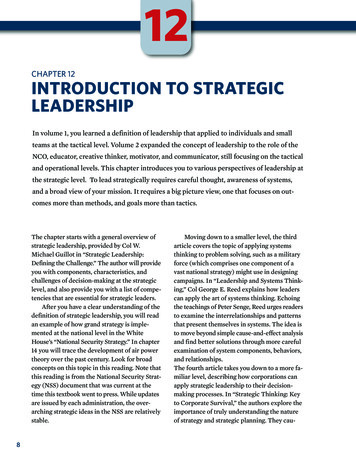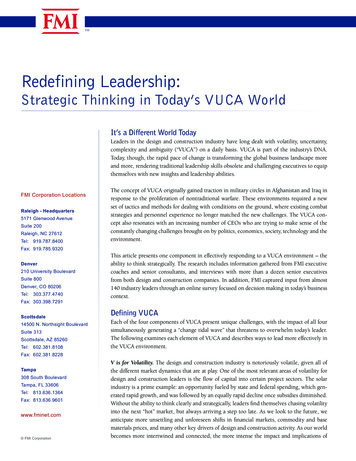
Transcription
:ftlDeparbnent of Command, Leadership, and Management Unili!d Slates Army War College · f2010
Department of Command, Leadership and ManagementUnited States Army War CollegeCarlisle Barracks, PA 17013-50503rct Edition edited byColonel (Ret) Stephen J. Gerras, Ph.D.Professor of Behavioral SciencesThis Primer is the result of several years of research by the faculty of the Department ofCommand, Leadership, and Management. Please forward comments to Dr. Steve Gerras, Box406 (phone: 717-245-3571).
TABLE OF CONTENTSPreface to 3rd EditioniiChapter 1 Introduction1Chapter 2 The Strategic Leadership Environment9Chapter 3 Vision20Chapter 4 Strategic Leader Competencies28Chapter 5 Strategic Decision Making Paradigms35Chapter 6 Strategic Leadership Tasks48Chapter 7 The Strategic Leader and the HumanDimension of Combat55Appendix A Strategic Leadership Competencies Monograph58i
PREFACE TO 3rd EDITIONThe original edition of the Strategic Leadership Primer, published in 1998, served theU S Army War College (USAWC) well as a basic overview of Strategic Leadership Writtenby Dr Rod Magee with the assistance of several other faculty members, it was intended asan orientation reading for students arriving at the USAWC whose backgrounds wereprimarily in the tactical and operational field environment The Primer was useful becausethere was no other adequate work that described and defined strategic leadership in terms thatcould be understood and applied by USAWC studentsA 2nd edition was published in 2004 and edited by Colonel (Ret) Steve Shambach This3rd edition updates significant portions of the Primer, especially Chapters 1, 2, and 3 andalso adds a chapter on decision making (Chapter 5) It is not that the nature of strategicleadership has changed drastically, rather this edition preserves the salient features ofthe original editions It is updated with contemporary literature and examples to sustain thePrimer’s relevanceThe editor acknowledges the tremendous contributions of Colonel Murf Clark andProfessor Charles Allen, along with editing assistance from Commander Traci Keegan andDr Richard Meinhart, while also acknowledging previous edition contributions from DrLenny Wong, Dr Craig Bullis, and Colonel (Ret) George Reedii
CHAPTER 1INTRODUCTIONIt became clear to me that at the age of 58 I would have to learnnew tricks that were not taught in the military manuals or on thebattlefield. In this position I am a political soldier and will have to putmy training in rapping-out orders and making snap decisions onthe back burner, and have to learn the arts of persuasion and guile. Imust become an expert in a whole new set of skills.George C MarshallGeneral Marshall is alleged to have made this observation as he reflected upon his earlyyears as Chief of Staff of the Army (CSA) in the beginning months of World War II Marshallapparently believed his previous education, training, and experience had not adequatelyprepared him for high-level leadership 1 As the CSA, his success depended upon his abilityto persuade influential people and organizations, both in and out of government, to employtheir efforts on behalf of his vision of a winning wartime strategy and to mobilize the Armyto make that strategy a reality General Marshall’s particular insights in this matter supportthe belief that beyond the direct and organizational levels is a third level of leadership: thestrategic level This Primer is intended to set the stage for a greater understanding and morein-depth study of leadership at the strategic level—the context, challenges, characteristics,and requirements of strategic leadership The purpose of this chapter is to provide anoverview of strategic leadershipGeneral Marshall seems to have intuitively understood that the development of a nationalstrategy and the force structure to execute that strategy required a complex decision makingstructure at the national and even international levels As CSA, Marshall collaboratedwith civilian leaders to develop a vast industrial war machine and coordinated amongthe allied nations to ensure unity of effort Since Marshall’s time as CSA, the politicalcomplexity of these national and international decision making structures has continued togrow Therefore, to be effective in today’s strategic arena, senior military leaders and theirstaffs must understand the Nation’s strategic vision and how strategy is formulated Aswell, they must appreciate the environment and multiple cultures in which they will operate,the competencies they must develop, and the tasks they must perform Bringing the sumof their intellect and experience to bear, they must conceive a positive vision of the futureand work towards those stated ends by developing policies and strategies that allow the cleararticulation of the corresponding ways and means In short, strategic leaders must succeed inan environment marked by volatility, uncertainty, complexity, and ambiguity (VUCA)1
Though the lines between these levels sometimes blur, we distinguish the strategiclevel of leadership from the tactical and operational levels in order to better understand theunique roles and responsibilities of today’s senior leaders At the turn of the 21st Century,discussions about the realities of military conflict in the Information Age have addressed theconcept of the “Strategic Corporal,” claiming that the mandates of strategic leadership nowhave the potential to extend to the lowest levels of military organizations—asserting thatthe most junior member’s actions can have strategic impact and implications This Primerasserts that this is very different from exercising strategic leadership yet, more than ever,every level of the organization must appreciate its responsibilities, functions and impacts atthe strategic level To accommodate this multi-level awareness requirement, strategic leadershave a responsibility to spread knowledge and values throughout their organizations by clearlycommunicating a vision, shaping climate, influencing culture, coaching, mentoring, teaching,and exemplifying appropriate behaviorsSo what is strategic leadership?leadership as:The USAWC has traditionally defined strategicThe process used by a leader to affect the achievement of a desirable andclearly understood vision by influencing the organizational culture, allocatingresources, directing through policy and directive, and building consensuswithin a volatile, uncertain, complex, and ambiguous global environment whichis marked by opportunities and threats.Differing slightly from the USAWC version, in 2008 CSA General George Caseyasserted:Strategic leaders guide the achievement of their organizational vision within alarger enterprise by directing policy and strategy, building consensus, acquiringand allocating resources, influencing organizational culture, and shaping complexand ambiguous external environments They lead by example to build effectiveorganizations, grow the next generation of leaders, energize subordinates, seekopportunities to advance organizational goals, and balance personal and professionaldemands 2Providing another perspective, Rich Hughes and Katherine Beatty from the Center forCreative Leadership asserted that:Individuals and teams enact strategic leadership when they think, act, and influencein ways that promote the sustainable competitive advantage of the organization 3An informal synthesis of these definitions may offer some common characteristics ofstrategic leadership First, strategic leadership often involves a comprehensive assessmentand interpretation of the external environment which, if interpreted effectively, is eventuallyaligned to the organization’s vision Second, although strategic leaders lead at the enterprise2
level and have great autonomy, they oftentimes need to build consensus across a wide rangeof stakeholders to properly make and execute decisions Third, aligning their organizationwith a rapidly changing environment implies that strategic leadership is about leadingand managing change to include the need to build a strategy and to align the resourcesand priorities to realize their vision In short, strategic leadership focuses on alignment,visioning, and changeALIGNMENTStrategic leaders most often operate at the enterprise level where various organizationalsub-systems converge to support the common purpose Subsequently, it is at this level wherestrategic leaders have decision making authority and influence over key organizationaldrivers such as strategy, structure, technology, and people Military leaders often attributethe title “strategic leader” to individuals who are, in fact, “leaders at the strategic level”as opposed to “strategic leaders ” The Joint Staff J-5 is clearly an important policy andplanning leader at the strategic level At the same time, however, the J-5 has only marginalinfluence on the military enterprise The J-5 can’t change promotion policies, pick thenext group of four-star generals, or make key decisions on weapons and technologyprocurements The J-5 makes recommendations to strategic leaders and surely needs tobe able to view through the lens of a strategic leader, but he does not wear the mantle of“strategic leader” as intended in this Primer This distinction is important when describingthe strategic leader requirement to provide alignmentStrategic leadership requires strategic leaders to initiate processes that ensure theirorganization scans the environment to maintain an awareness of societal, international,technological, demographic, and economic developments Chapter 2 discusses elementsof the relevant external environment for military leaders The primary role in thisenvironmental scanning process for the strategic leader is to interpret the scanned data todetermine the organization’s response For example, if the CSA learns from the generalin charge of Accessions Command that high-school recruits don’t have the requisite mathskills to operate many of the Army’s high-tech systems, the Chief needs to interpret thisdata and then explain to relevant stakeholders what this observation means to the Army andthe nation He then needs to solicit ideas from his senior civilian and military leaders fortaking action, decide a course for the organization, and influence external decision makersto collaborate on solutionsOn a holistic level, the interpretation of environmental scanning in a VUCA world oughtto lead to the creation of a vision that is aligned with a best estimate of the future environmentThe organization’s vision represents an idealized representation of what the organizationshould strive to become The subsequently developed strategy, however, should explicitlyalign ends (objectives), ways (concepts and methods), and means (resources) to ensure theorganization’s resources are committed in a manner that allow the organization to succeedin its current and future environments—in short—to enact the vision Strategic leadersmust therefore ensure that they align the vision with their interpretation of the changing3
environment, and that the organization’s strategy is aligned with this vision Similarly,the structure, culture, personnel policies, and technology also need to be aligned with thevision and strategy in order to achieve the vision and maintain competitive advantageAlignment needs to be both vertical — the lowest levels of the organization understand andaccept the big picture, and horizontal — each of the stovepipes that come together at thestrategic level are in syncAs an example, early in Operation Iraqi Freedom Army leadership realized its visionand strategy required a decentralized, deployable, and agile force structure to meet theheavy demands of the contemporary operating environment The CSA concluded that theArmy’s division-centric structure was out of alignment with this requirement and thereforedirected a rapid re-structuring to a brigade-centric Army This restructuring exemplifieshow a strategic leader aligns organizational structure with mission requirements to realizea vision Similarly, in 2009, the Army concluded its culture was not aligned to addresstwo major health issues affecting soldiers deployed in support of Operations Iraqi andEnduring Freedom, specifically post traumatic stress disorder (PTSD) and mild traumaticbrain injury (MTBI) Aspects of Army culture reinforced long-held negative stereotypesabout Soldiers who reported non-visible health issues like PTSD and MTBI Given theimpact and frequency of PTSD and MTBI in the wartime Army, Army leadership created astrategic communications plan to attempt to align Army culture to deal appropriately withthese common wartime health issuesThe preceding paragraphs frequently referred to terms we often think of as civilianmanagement terms Military officers routinely frown when leadership conversations turnto a discussion of terms like core competencies, enterprise leadership, and competitiveadvantage As strategic leaders, however, these terms are part of the vernacular Of thethree, the one most often denigrated as a “corporate” term (and therefore not viewed asapplicable to the military) is competitive advantage In a section on alignment it is prudentto attempt to change this negative reaction Scholars of strategic leadership have arguedthat the primary focus of strategy, and hence strategic leaders, is to achieve sustainablecompetitive advantage for their organization—the focus is on winning now AND in thelong termIronically, one must wonder why the term “competitive advantage” would receivepushback from a warfighting organization Clearly all the military services desire toachieve a vision, especially in terms of strategy, technology, structure, and culture, thatpositions the Services to defeat America’s current and future potential foes In short,they want competitive advantage Unfortunately, the relationship between competitiveadvantage, the corporate world, and the military usually drives the discourse to an analysisof the competition over resources between each of the military Services plus other federalagencies This discussion is sometimes uncomfortable for military leaders, but it needs tooccur4
Commercial and government organizations compete in different ways, but they all are incompetition with some other entity 4 The primary difference is that the governmental agencyprovides services to a broad client base (e g , citizens) and in fact competes for resourcesby contending with other government agencies that seek to provide a specific service orperform a given function Commercial organizations seek to dominate markets and buildmarket share by price competition, product differentiation and quality, or even monopolyformation that simply excludes competitors Governmental agencies compete againstother agencies in more limited and nuanced ways For instance, they seek monopoly statusby exclusive ownership of a mission Agencies also attempt to broaden their populationserved to build a larger, long-term client base They (or stakeholder lobbies) buildrelationships with the legislative authorizers and appropriators in Congress to guaranteeagency programs are funded in the future Anyone who does not think the discussion withinthe Department of Defense (DOD) over cyberspace isn’t about competitive advantage foreach of the military services does not understand the subtleties of strategic leadershipThis competitive advantage focuses on potential enemies, but also on the allocation ofresources to fight the cyber war Although the strategies are different between commercialand government entities, at the end of the day both seek competitive advantage to ensurethe continued flow of resources These resources, in most cases, are generally limited andtherefore, to some extent, create a zero-sum competitionVISIONINGThe preceding section introduced the importance of the concept of alignment, whichensures sustainable competitive advantage Despite its importance, however, most strategicleadership scholars, and strategic leaders themselves, cite the ability to develop andarticulate a compelling vision as the most important task of strategic leadership Chapter3 covers this topic in detail and emphasizes that: (1) the visioning process is a team sport;the strategic leader alone cannot create and communicate an organizational vision, (2)communicating a vision takes a great deal of effort Strategic leaders must often repeat aclear and concise message many times, in many places, to ensure the vision cascades downthrough the organization, and (3) actions speak louder than words Most observers willquickly detect when the espoused vision is not aligned with enacted values and priorities,thereby decreasing the chances of achieving the visionCHANGEMany well-written books describe how to lead an organization through change JohnKotter’s Leading Change stands out as one of the best of the genre 5 Kotter pointed out thatindividual or organizational change at its most basic involves three processes: unfreezing,changing, and refreezing The unfreezing step requires that stakeholders and participantsview the current situation as unsuitable The change step focuses on enacting changes withinvarious components of the enterprise, to include structure, strategy, people, technology, or5
culture The refreezing step attempts to make those changes a permanent aspect of theorganization Chapter 6 of this primer discusses managing change as a strategic leadertask Suffice it to say that if the environment is changing at a faster and faster rate, thenstrategic leaders need to build organizations that can change even faster to align with theenvironment For example, the 1950s-era General Motors bureaucratic model, rooted ininertia-plagued hierarchies, is probably in the distant past for most public and private sectororganizationsTHE STRATEGIC LEADERSHIP TEAMTop leaders of any organization, including staff members, share the responsibility ofstrategic leadership Realistically, only one or two percent of the members of an organizationwill ever attain strategic leadership rank or position, but, anyone working directly for astrategic leader should be well-versed in strategic thinking concepts in order to adequatelysupport and advise the leader. Effective strategic decision making and leadership cannotreside merely in one leader The changing external environment and the complexity of largeorganizations create a situation where the leader at the top of the organizational hierarchycannot possibly lead the organization without receiving help in information gathering,assessment, and knowledge management Effective leadership depends on the interactionsamongst the leader, those being led or influenced (both in and out of the organization) andthe situation or circumstances facing the organization The complexity of these relationshipsand interactions determine the effectiveness of strategic leaders and their teams Therefore,this Primer focuses on the concept of strategic leadership, rather than the strategic leaderaloneWhile the need exists for senior officers to transition to the strategic level of leadership,the leadership skills and qualities developed at the direct and organizational levels remaininvaluable The strategic leader must still exercise direct leadership of his subordinatecommanders and staff At the same time, the strategic leader must manage and lead a verylarge and complex organization, represent the organization to the external environment,and wield influence to shape the external environment to help the organization accomplishits vision and purpose More so than at any other level of leadership, strategic leadershiprequires proactive consensus building and collaboration with other organizations, agenciesand nations At the same time, though the primary focus turns outward, the leader mustalso tend to the internal organizational environment Excessive focus inside or outsidethe organization will detract from organizational success and perhaps even viability Thekeys to a successful transition to strategic leadership are an appreciation for the dramaticincrease in scope of leadership responsibilities, an understanding of the unique natureof these increased responsibilities, and the dedication of effort necessary to understand andinfluence the complex and dynamic environment in which these leadership responsibilitiesreside Beyond understanding this strategic environment, strategic leaders and their staffsmust exercise strategic leadership competencies to achieve their vision within that volatile,uncertain, complex, and ambiguous environment Leadership expert John Gardner asserted:6
.the hierarchical position of leaders within their own system is oflimited value, because some of the most critically important tasks requirelateral leadership---boundary-crossing leadership—involving groups overwhom they have no control. They must exercise leader like influence beyondthe system over which they preside. They must do what they can to leadwithout authority.6 (bold added for emphasis)STEWARDSHIPFinally, professional ethics play a foundational role in the effectiveness of strategicleaders All professions share some common traits, among them a shared value system, acontribution to society, a specialized jurisdiction, and an internal, self-policing mechanismAt the strategic level of leadership, these qualities manifest themselves most distinctly inthe requirement for a responsible use of powerFor example, effective strategic leaders and their teams are cognizant of the amplifiedimpact of their decisions Whether they are conducting a war, developing a strategy,or investing in military capabilities, they appreciate the gravity of their office Almostby definition, effective strategic leaders take an expansive view of their stewardshipresponsibilities toward the long term health of the institution They exercise a warinessof their natural tendency to act in their self-interest and build a small cadre of advisors oraccountability partners to protect themselves from personal mistakes that can affect theentire organization The strategic leader who conducts himself with a selfless professionalethic builds public trust, and in the process accumulates a reservoir of moral authority thatserves both his office and the institution wellSUMMARYStrategic leadership is generally a team sport that requires a strategic leader-led visioningprocess to create the alignment between the organization’s strengths and weaknesses andthe anticipated demands of the future external environment Strategic leaders understandthe importance of vertical and horizontal alignment, ensuring the vision and strategy of theorganization align with the processes, structures, culture, and technology of the organizationFinally, strategic leaders are the change agents that enact the constant realignments requiredin the 21st century’s VUCA environmentENDNOTES1 Marshall was promoted from Brigadier General directly to General on September 1, 1939, so hisexperience is atypical, but still well illustrates the different skills and perspectives needed by the most seniorleaders2 General Casey presentation to the USAWC, September 22, 2008 Cited with permission of Office ofChief of Staff7
3 Richard L Hughes and Katherine C Beatty, Becoming a Strategic Leader (San Francisco: Wiley andSons, 2005): p 94 See T O Jacobs, Strategic Leadership: The Competitive Edge (unpublished manuscript, 2002): p 10for a more detailed comparison of civilian and government organizations5 John Kotter, Leading Change (Boston: Harvard Business School Press, 1996)6 John Gardner, On Leadership (New York: The Free Press, 1990): p 988
CHAPTER 2THE STRATEGIC LEADERSHIP ENVIRONMENT II don’t think I am exaggerating when I say that we face the most dauntingstrategic environment in generations 1Under Secretary of Defense for Policy, 2009These times are, one might say, ordinary times, a slice of life like any other.Who can bear to hear this, or who will consider it? Are we not especiallysignificant because our century is – our century and its nuclear bombs, itsunique and unprecedented Holocaust, its serial exterminations and refugeepopulations, our century and its warming, its silicon chips, men on themoon, and spliced genes? No, we are not and it is not 2Annie Dillard, The Wreck of Time; Taking Our Century’s MeasureA human being is not one thing among others; things determine eachother, but man is ultimately self-determining. What he becomes—withinlimits of endowment and environment—he has made out of himself. Inthe concentration camp, we watched and witnessed some of our comradesbehave like swine while others behaved like saints. Man has both potentialswithin himself; while one is actualized depends on decisions but not onconditions 3 (bold emphasis added)Victor Frankl, Man’s Search for MeaningCarlisle, PA May, 2010 Twitter limits the Chairman of the Joint Chiefs of Staff—andeveryone else—to 140 characters per tweet, and he tweets once or more almost daily 4 400million people have established accounts on Facebook 5 Worldwide, approximately 33million people are living with HIV 6 Mandatory entitlement programs account for over 2trillion of the 3 55 trillion 2010 Federal Budget and the Office of Management and Budgetestimates that the percentage of the national debt held by the public will increase from 58 7%to 67 2% in the next 10 years 7 Personal bankruptcies have doubled in the U S in the last 20years, and quadrupled between 1980 and 2000 8 The U S military budget dwarfs the defensebudget of China by a multiple of at least four (depending on how one calculates) 9 10 11IThis chapter was significantly updated for the 3rd edition by Colonel Murf Clark9
Which of these facts is relevant to a military leader?For the first time in its history, in 2009, the NFL issued guidelines for players sufferingconcussions 12 The U S Energy Information Administration estimates that between now and2030 the percentage of electricity the world gets from nuclear power will decrease from 15to 12 percent 13 The fastest growing population segment in most industrialized countries iscentenarians 14Should you care?A recent Harvard Business Review article recommended asking questions that challengethe status quo in your organization “at least 10 times each day ”15Is that a good idea for leaders in the U S military? Do you spend time considering whatconstitutes “the status quo in your organization?”Senator Kirk, who in September 2009 replaced longtime Senator Edward Kennedy onthe Senate Armed Services Committee, questioned Chairman Mullen in the wake of thepresident’s December 1, 2009 announcement of a troop surge for Afghanistan 16Do you know what they said? Should such testimony influence your thinking?Amidst much clamor about “unprecedented change” brought on by the Information Age,Foreign Policy magazine quotes an economist who believes the continued proliferation ofthe plain old TV has much more potential to change the world than the internet and wirelesstechnology 17 Despite claims about the overwhelming technology leaps being made byIndia and China, internet penetration in those countries (7% and 29% of total population,respectively) remains far below North America (74%) and most other western democracies 18What knowledge can leaders derive from this information and how can they managethe gathering, sorting, and assessing of that knowledge in order to better understand theenvironment in which they must make decisions and lead large organizations into the future?Many of the facts in the previous paragraphs will be outdated or less relevant by the timeof publication; that fact alone further illustrates the challenge of environmental scanningand strategic decision making in the Information Age Because of the multiplicity of factorsand influences at play and the long lead times required for change in large organizations,strategic leadership requires a much broader skill set than leadership practiced at lowerlevels Strategic decision making is extremely difficult, requiring exhaustive research,analysis, collaboration, and compromise to reach the best possible solutions to problemsEven highly experienced leaders—especially highly experienced leaders—may be temptedto substitute “educated guessing” or “intuition” for sound processes of information gathering,assessment, and risk management Resource constraints and political considerations may10
interfere The competitive environment demands that organizations assume risk In StrategicLeadership; The Competitive Edge, T Owen Jacobs describes the external environmentas filled with Volatility, Uncertainty, Complexity, and Ambiguity; hence, the acronym,“VUCA ” That the environment of the Information Age is fraught with VUCA does littleto excuse irresponsibility, carelessness, or a lack of rigor when attempting to understandthe environment, anticipate change, and manage risk 21st Century leaders must approachthis challenge with intelligence, energy, and urgency, confident that these realities andcomplexities can as easily be transformed into a competitive advantage when turned againstthe enemies of our nationGiven the extent of their responsibilities and the expanding effects of their decisions,strategic leaders must consider a vast array of facts, influences, and participants To saythey must consider all things may be only a slight exaggeration Therein lies the rub Withlimited time and finite knowledge, effective leaders must literally decide how to decideThat is, they must determine which elements of their environment are most important to aparticular situation or decision and then focus their attention and efforts thereStrategic leaders and strategists must attempt to understand, interpret, and master theVUCA environment Jacobs suggests leaders cannot attain complete knowledge about themany factors governing strategic decisions Nonetheless, leadership requires that decisionsbe made To answer the challenge of VUCA, we must first unde
A 2nd edition was published in 2004 and edited by Colonel (Ret) Steve Shambach This 3rd edition updates signiicant portions of the Primer, especially Chapters 1, 2, and 3 and also adds a chapter on decision










